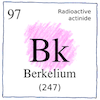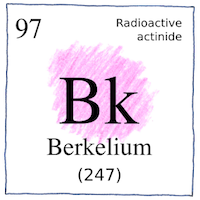Berkeley—Glenn T. Seaborg,
Albert Ghiorso,
Stanley Gerald Thompson
elements

|
Berkelium
Thompson, Ghiorso, and Seaborg produced element 97 by bombarding americium in a cyclotron with deuterons.
Atomic number 97
Scientists in the United States have produced only a little more than a gram of berkelium, and none of its isotopes have a half-life long enough to have remained on Earth except for areas affected by nuclear power, accidents, and bomb detonations, even from the natural nuclear fission reactors at Oklo.
Analogues
The people at Berkeley (pronounced BERK-ly) followed the naming rules of the lanthanides in the periodic table above the actinides they synthesized. Above element 95 is europium, named after the continent where it was found, Europe, so they named americium after America. Above element 96 is gadolinium, which honors a scientist who studied rare earths, Johan Gadolin, so curium honors Marie and Pierre Curie. Above element 97 is terbium, named after the town where it was found, Ytterby, Sweden, so they named berkelium after Berkeley.



They named americium, curium, and berkelium as their chemical homologues were named, but they named neptunium and plutonium, which follow uranium in the periodic table, according to the planetary sequence—Uranus, Neptune, and Pluto (which was considered at the time to be a planet).
See also in The book of science:
Readings in wikipedia:
Other readings: